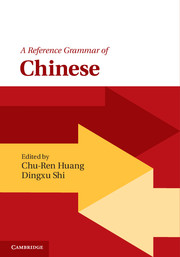Book contents
- Frontmatter
- Dedication
- Contents
- List of figures
- List of tables
- List of contributors
- Preface
- Acknowledgements
- English–Chinese term list
- Chinese–English term list
- 1 Preliminaries
- 2 Syntactic overview
- 3 Lexical word formation
- 4 Verbs and verb phrases
- 5 Aspectual system
- 6 Negation
- 7 Classifiers
- 8 Nouns and nominal phrases
- 9 Relative constructions
- 10 Adjectives and adjective phrases
- 11 Comparison
- 12 Adverbs
- 13 Prepositions and preposition phrases
- 14 Sentence types
- 15 Major non-canonical clause types: ba and bei
- 16 Deixis and anaphora
- 17 Information structure
- Appendix: Punctuation
- Bibliography
- Index
16 - Deixis and anaphora
Published online by Cambridge University Press: 05 March 2016
- Frontmatter
- Dedication
- Contents
- List of figures
- List of tables
- List of contributors
- Preface
- Acknowledgements
- English–Chinese term list
- Chinese–English term list
- 1 Preliminaries
- 2 Syntactic overview
- 3 Lexical word formation
- 4 Verbs and verb phrases
- 5 Aspectual system
- 6 Negation
- 7 Classifiers
- 8 Nouns and nominal phrases
- 9 Relative constructions
- 10 Adjectives and adjective phrases
- 11 Comparison
- 12 Adverbs
- 13 Prepositions and preposition phrases
- 14 Sentence types
- 15 Major non-canonical clause types: ba and bei
- 16 Deixis and anaphora
- 17 Information structure
- Appendix: Punctuation
- Bibliography
- Index
Summary
This chapter describes the main types and usages of deictics and anaphors. The phenomenon of deixis involves the use of a word or phrase whose interpretation is determined through considerations of the physical properties in the situation of utterance, from the perspective of the speaker or the addressee who are engaged in the act of communication. When the need to make further structural distinctions is in order, a deictic consisting of one single word is referred to as a “deictic term,” while a larger deictic built around a deictic term is referred to as a “deictic expression.”
Anaphora as a phenomenon is defined as a co-referential relationship between an anaphor and its antecedent. Such a relation can be established either within a clause or beyond, resulting in unification or partial overlap in reference. For ease of exposition, an anaphor consisting of one single word is given the label “anaphoric term,” while a larger one built around an anaphoric term is labeled “anaphoric expression.”
Deixis and anaphora are studied together because, given the existence of a few dedicated deictics (such as 我 wo3 ‘I,’ 你 ni3 ‘you,’ and 现在 xian4zai4 ‘now’) and prototypical anaphors (such as 他 ta1 ‘he’), there also exists a closed set of common terms and expressions that can have both usages (such as 那里 na4li3 ‘there’ and 那时 na4shi2 ‘then’). The distinctive properties of deixis and anaphora are as listed below.
Deictics and anaphors typically take the form of pronouns, nouns, and, to a lesser extent, verbs and adverbs. Some deictic expressions can take the form of fixed idiomatic constructions.
The very basic deictics and anaphors are pronouns, whose usages form a cluster of systematic variations that bear language-specific characteristics.
Both deictics and anaphors have under-specified content that needs to be fully instantiated in actual language use, with reference to syntactic and discourse information.
Different manners of instantiation lead to distinctions between deictic and anaphoric uses. The value of a deictic is specified with reference to some non-linguistic information gathered from the situation of utterance. On the other hand, the value of an anaphor is determined through total or partial co-reference with an antecedent, which is identified in the linguistic context.
Some terms can be used either deictically or anaphorically, depending on the context.
Information
- Type
- Chapter
- Information
- A Reference Grammar of Chinese , pp. 484 - 517Publisher: Cambridge University PressPrint publication year: 2016
Accessibility standard: Unknown
- 1
- Cited by
